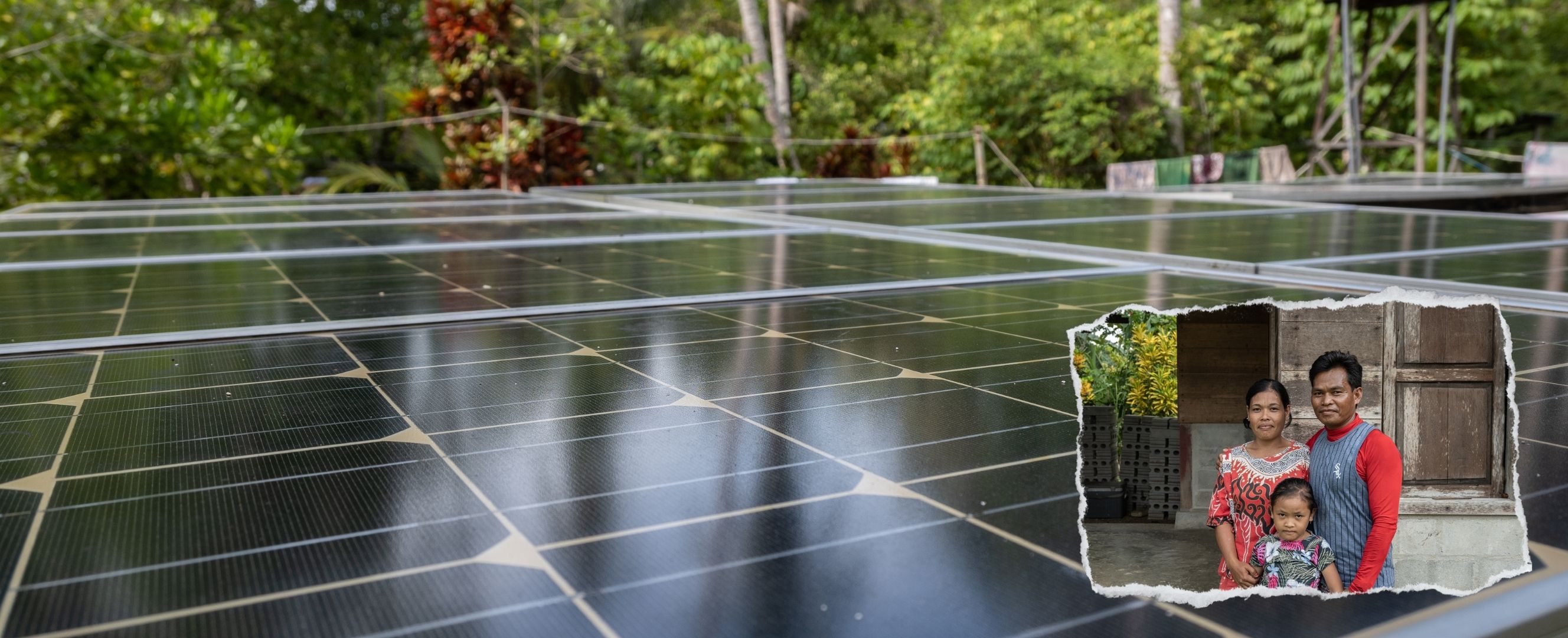The archipelago must overcome many challenges to wean itself off fossil fuels
In 2017 Pardinan Sakerebau’s family home in Pukurayat, an off-grid hamlet in Indonesia’s Mentawai archipelago, received electric lighting for the first time from four lamps powered by a rooftop solar panel. During the same year, surfer Pete Anderson invested more than $10,000 in photovoltaic equipment for his home on a small island 15 kilometers north of Pukurayat.
Today only one of Sakerebau’s lamps is functioning: the batteries are broken. Anderson’s solar panels have been repurposed to hang laundry after a lightning bolt scorched the system’s $5,000 inverter, which is needed to convert solar-generated energy to alternating current.
“It’s cheaper for me to buy a generator every year and just run gasoline—I’m bummed,” said Anderson, a Californian fine arts graduate.
Perceptions that photovoltaic energy is expensive and high-maintenance explain in part why Indonesia—a sprawling archipelago of 17,000 islands bisected by the equator, with fairly constant year-round sunshine—has the least installed solar energy among G20 countries. This is despite the country’s international commitments to reduce carbon emissions and wean itself off fossil fuels.
Several communities on the 70 islands that make up the Mentawai island chain, one of more than 60 regions of Indonesia defined by the government as underdeveloped, received electricity for the first time from basic solar technology.
But despite having more potential solar energy than all the world’s power plants combined, photovoltaics accounted for less than 200 megawatts on electricity grids across the world’s fourth-most-populous country in 2021. That was less than 0.1 percent of total installed capacity.
Fabby Tumiwa, head of the Indonesian Solar Association and a former climate change negotiator, attributes such low solar energy use to the political economy of coal, which is plentiful in Indonesia and can be extracted cheaply.
“Coal was seen as the cheapest form of energy,” says Tumiwa. “Renewables were forced to compete—it was hard to compete with coal.”
Indonesia is the world’s largest exporter of thermal coal, and the state grid, Perusahaan Listrik Negara (PLN), relies on domestic supplies to power two-thirds of electricity generation.
In outlying islands, where coal power stations are not economical, smaller plants provide electricity by burning millions of liters of diesel at a cost of up to 22 cents a kilowatt-hour, accounting for about 7 percent of Indonesia’s electricity capacity.
To attract investment, PLN offered independent power producers long-term contracts, which locked the state-owned grid into guaranteed coal payments even as electricity supply outpaced demand.
Questions remain over how the decommissioning of old coal plants will be financed. This year, State-Owned Enterprises minister Erick Thohir said that retiring 15 gigawatts of coal capacity by 2050 could cost $600 billion.
In the near term, PLN plans to trim emissions from its coal fleet by co-firing coal with biomass, such as sawdust and household waste. But Putra Adhiguna, an analyst at the US-based Institute for Energy Economics and Financial Analysis (IEEFA), said that this will require a dedicated biomass industry to be built from scratch.
Brighter outlook
Indonesia’s solar industry hopes a brighter outlook is around the corner as photovoltaic costs continue to come down and reforms improve the business case.
In 2015 President Joko Widodo opened what was then the country’s largest solar power plant, in eastern Indonesia; the electricity it generates costs a steep 25 cents a kilowatt-hour.
Since then several new facilities have come online on islands east of Java. This year, PLN signed power purchase agreements at less than 6 cents a kilowatt-hour for 50 megawatts of solar power in Bali.
In August the government added a multibillion-dollar solar project in the Riau Islands to the docket of national priority projects. If it is built, the project could export clean energy to Singapore and catalyze a domestic solar manufacturing industry, analysts say.
Last year, Indonesia’s energy ministry approved a new 10-year business plan in which renewable projects make up more than half of planned new capacity, up 25 percent from the previous blueprint.
Indonesia’s energy ministry has introduced improved terms for rooftop on-grid solar capacity, cutting permit times and increasing the export allowance from 65 percent of excess electricity generated to 100 percent, although how PLN implements these changes on the ground will be crucial, analysts say.
The 2021 regulation also set a target of 3.6 gigawatts of rooftop solar capacity by 2025—equivalent to more than 1,000 large-scale wind turbines—which the government hopes will support more than 100,000 jobs and prevent 4.6 million tons of carbon emissions.
According to the Jakarta-based Institute for Essential Services Reform, conversations with about 30 developers indicated that 3.3 gigawatts of rooftop solar capacity was set to come online by the end of next year.
Indonesia has been “relatively successful” in bringing rudimentary electrification to remote off-grid areas like Pukurayat using basic solar panels and batteries, says the IEEFA’s Adhiguna.
Despite the high solar potential on Indonesia’s dominant Java-Bali network, smaller grids reliant on diesel in eastern Indonesia are expected to see quicker solar uptake in the near term as the government seeks to retire thousands of diesel plants.
In June 2019, PLN reported that solar energy accounted for 0.1 percent of the electricity generated on Lombok, one of the Nusa Tenggara Islands, in southeast Indonesia. However, by the end of that year the share had increased to 2.8 percent.
“Nusa Tenggara has the best solar reserves in Indonesia,” says Tumiwa. “It should be dominant there.”
The regional government wants renewable sources, mainly solar, to drive 35 percent of electricity generation in the province of about 5 million by 2025—higher than the central government’s national target of 23 percent.
Indonesia has committed to cutting emissions 31.9 percent by 2030 under plans Widodo submitted to the United Nations Framework Convention on Climate Change in September.
But the arrival of renewable energy can mean a more immediate reduction in harm in communities like Pukurayat and much of eastern Indonesia.
Indoor combustion of fuels such as firewood and kerosene causes thousands of pneumonia deaths every year among Indonesian children under 5, according to UNICEF, the children’s charity.
Prior to receiving four lamps and a solar panel in 2017, Sakerebau’s family lit their home using an open container of kerosene, a homespun candle known in the Mentawai Islands as an alito that is a well-known cause of air pollution and house fires.
"We used to be afraid," said Sakerebau.
Opinions expressed in articles and other materials are those of the authors; they do not necessarily reflect IMF policy.









